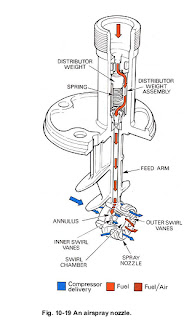want to read about : Starting and ignition - Hydraulic
IGNITION
18. High-energy (H.E.) ignition is used for starting all jet engines and a dual system is always fitted. Each system has an ignition unit connected to its own igniter plug, the two plugs being situated in different positions in the combustion system.
19. Each H.E. ignition unit receives a low voltage supply, controlled by the starting system electrical circuit, from the aircraft electrical system. The electrical energy is stored in the unit until, at a pre- determined value, the energy is dissipated as a high voltage, high amperage discharge across the igniter plug.
20. Ignition units are rated in 'joules' (one joule equals one watt per second). They are designed to give outputs which may vary according to require- ments. A high value output (e.g. twelve joule) is necessary to ensure that the engine will obtain a sat- isfactory relight at high altitudes and is sometimes necessary for starting. However, under certain flight conditions, such as icing or take-off in heavy rain or snow, it may be necessary to have the ignition system continuously operating to give an automatic relight should flame extinction occur. For this condition, a low value output (e.g. three to six joule) is preferred because it results in a longer life of the igniter plug and ignition unit. Consequently, to suit all engine operating conditions, a combined system giving a high and low value output is favoured. Such a system would consist of one unit emitting a high output to one igniter plug, and a second unit giving a low output to a second igniter plug. However, some ignition units are capable o! supplying both high and low outputs, the value being pre-selected asrequired.
21. An ignition unit may be supplied with direct current (D.C.) and operated by a trembler mechanism or a transistor chopper circuit, or supplied with alternating current (A.C.) and operated by a transformer. The operation of each type of unit is described in the subsequent paragraphs.
 |
| Fig. 11-10 A D.C. trembler-operated ignition unit. |
22. The ignition unit shown in fig. 11-10 is atypical D.C. trembler-operated unit. An induction coil, operated by the trembler mechanism, charges the reservoir capacitor (condenser) through a high voltage rectifier. When the voltage in the capacitor is equal to the breakdown value of a sealed discharge gap, the energy is discharged across the face of the igniter plug. A choke is fitted to extend the duration of the discharge and a discharge resistor is fitted to ensure that any residual stored energy in the capacitor is dissipated within one minute of the system being switched off. A safety resistor is fitted to enable the unit to operate safely, even when the high tension lead is disconnected and isolated.
23. Operation of the transistorized ignition unit is similar to that of the D.C. trembler-operated unit, except that the trembler-unit is replaced by a transistor chopper circuit. A typical transistorized unit is shown in fig. 11-11;
































